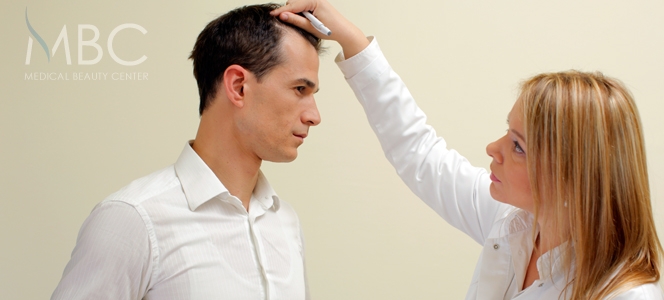
Today hair loss is a major issue for millions of men and women. No matter how common it is, it is a stressful experience to deal with for both genders. Everyday work with our patients indicate that it can cause significant loss of self confidence, emotional vulnerability, thinking that they are less attractive and even depression.
Majority of men and women lose between 50 to 100 strands of hair per day. This is truly insignificant as an average person has around 100,000 follicles of hair. As we grow older, it is natural for our hair to thin out. Other causes of hair loss are hormonal changes, certain medical conditions and medication.
Most common cause of hair loss is genetic predisposition known as androgenic alopecia or alopecia androgenetica in men (male pattern baldness) and women (female pattern baldness). In genetically predisposed individuals certain gender hormones trigger the action that might lead to permanent hair loss. This condition is frequently seen in male population and can start as early as puberty.
Causes of hair loss are different as are the options for medically treating, preventing further hair loss and replacing the lost strands of hair. However, if permanent hair loss has occurred in a certain area, the only option is hair transplant. If you are experiencing such hair loss and are ready to restore your hair, we are expecting you at MBC!
Other causes of hair loss
1. Telogen Effluvium:
This is a condition that results in rapid and dramatic hair loss. Healthy hair is lost and significantly diminished within weeks and might cause severe thinning of hair. Fortunately, often the process is fully reversible! Hair strands are lost due to premature follicle maturation and entering the last phase of hair growth unexpectedly. Causes of Telogen Effluvium are serious infections, lack of protein, side effects of medication such as anticoagulants, beta blockers, diuretics, anti-inflammatory medication, antidepressants, hormonal substitution with progesterone, vitamin A, certain medication for diabetes etc.
2. Anagen Effluvium
Anagen Effluvium is a diffuse hair loss like Telogen Effluvium, but it develops much more rapidly and can cause complete hair loss in some individuals. It is usually seen during chemotherapy and in people taking cytostatic drugs for cancer. It is reversible, but not always fully. In many the recovery can be rapid and there should be normal hair growth density, however some people will find changes in their hair quality and sometimes these changes will be permanent.
3. Alopecia Areata
Alopecia areata can affect men, women and children. It manifests as well defined circular bald patches on the scalp. Many people will get just one or two patches, but for some hair loss can be as extensive and result in complete hair loss. It is considered autoimmune disease where the immune system inappropriately activates and attacks hair follicles. Certain triggers, such as some types of lymphocytes attack hair follicles mistaking them for a threat to the rest of the body. Often, within a month to a year hair will start to grow back and patients will see improvement of hair growth. Unfortunately, if hair loss is extensive (over half of the head) chances for new hair growth are diminished. One in five affected will develop Alopecia Totalis (complete scalp hair loss) and one in ten will experience Alopecia Universalis, condition that causes loss of hair over the entire body.
Extreme hair loss is more likely if condition develops during childhood, if it extends to over half of the scalp, in cases of atopic eczema, loss of eye brows and eye lashes and in individuals with genetic predisposition and family members who have the same condition as well and with different autoimmune diseases.
Treatments Alopecia Areata
There is often spontaneous improvement with no treatment.
In certain cases corticosteroid creams and injections are recommended. Injections should be applied 1cm apart for four to six weeks. Results will need at least one to two months after the first treatment. However, this treatment is not successful in all the cases. Topical corticosteroids can be applied but if there is no improvement after six months such therapy will no longer be recommended and should be discontinued.
Monoxidil lotion can cause improvement in some cases. However, if there is no improvement it should be discontinued after one year.
Hair transplant is an option for treating such hair loss if primary treatments were unsuccessful. It is important to mention that in cases of Alopecia Areata we cannot be certain that transplanted hair will not be in future affected with the same medical condition.
4. Cicatricial Alopecia
Cicatricial Alopecia, also known as scarring alopecia, is extremely rare hair loss, accounting for less than 3% of all of the hair loss patients. It is caused by dissecting cellulitis, follicular degeneration syndrome, lichen planoplaris and pseudopelade of Brocq etc. Very rarely it can be caused by a brow or face lift. It is unfortunately potentially permanent and irreversible destruction of hair follicles.
5. Trichotilomania
This is one of potential causes of hair loss and it is a result of constant pulling out and breaking the hair. It is most often seen in women and before a treatment it is recommended to see a psychiatrist.
6. Traction Alopecia
This condition is caused by trauma to the hair follicles due to a certain types of hair styles, particularly ones that pull at hair over longer period of time, such as tight ponytails and braiding. It detected early enough the hair will re-grow.
7. Other causes
Bacterial and fungal infections (tinea capitis for example) can also cause hair loss.
Experience, knowledge and professionalism for Your great looks and health!
Yours MBC

 Srbija:
Srbija:  Ireland:
Ireland:  UK:
UK:  Denmark:
Denmark:  Italy:
Italy: